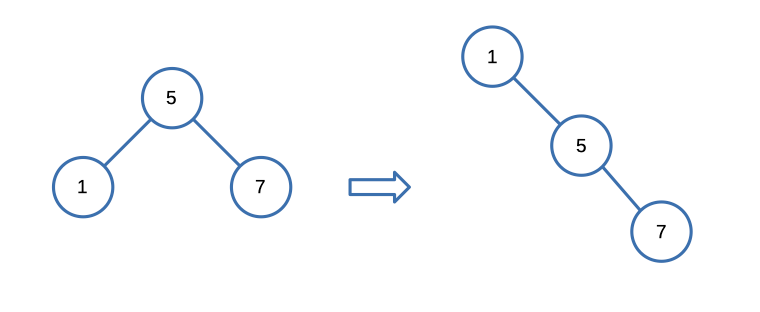LeetCode: 897. Increasing Order Search Tree
The Problem
Given the root of a binary search tree, rearrange the tree in in-order so that the leftmost node in the tree is now the root of the tree, and every node has no left child and only one right child.
Example

Input: [5,1,7]
Output: [1,null,5,null,7]Constraints:
- The number of nodes in the given tree will be in the range
[1, 100]. 0 <= Node.val <= 1000
Solution
We opted for a recursive approach to tackle this problem, and upon evaluating our solution on the LeetCode platform, we achieved the following outcome:

Here's the code that led us to this result.
TreeNode* increasingBST(TreeNode* root) {
if(root == nullptr) return root;
vector<TreeNode*> vec;
increasingBST(root, vec);
TreeNode* ans = vec.front();
TreeNode* head = ans;
ans->left = NULL;
ans->right = NULL;
for(int i = 1; i < vec.size(); ++i){
head->right = vec[i];
head = head->right;
head->right = NULL;
head->left = NULL;
}
return ans;
}
void increasingBST(TreeNode* root, vector<TreeNode*> &vec) {
if(root == nullptr) return;
increasingBST(root->left, vec);
vec.push_back(root);
increasingBST(root->right, vec);
}🧠
Github with all the solution including test cases.
Let's break it down step by step:
- The goal of this code is to restructure a binary search tree to create a new tree where all the nodes are connected in increasing order.
- The
TreeNodestructure likely represents a node in a binary tree, with properties likeleftandrightrepresenting the left and right child nodes. - The
increasingBSTfunction is a helper function that traverses the original tree (in-order traversal) and collects nodes in an increasing order in thevecvector. - The
increasingBSTfunction does this by recursively visiting the left subtree, adding the current node to thevecvector, and then visiting the right subtree. - The main
increasingBSTfunction is called with the root of the original tree and thevecvector as arguments. This will populate thevecvector with the nodes of the original tree in increasing order. - After the
vecvector is populated, the code creates a new BST using the nodes from thevecvector. It starts by setting the first node in the vector as theansnode. - The loop then iterates through the remaining nodes in the
vecvector and connects them to theansnode's right child. It updates theheadnode to the newly connected node after each iteration. - During each iteration, the code also removes any connections to the left or right children of the newly connected node, effectively creating a new right-leaning BST.
- Finally, the
ansnode is returned, representing the root of the new BST with nodes connected in increasing order.
